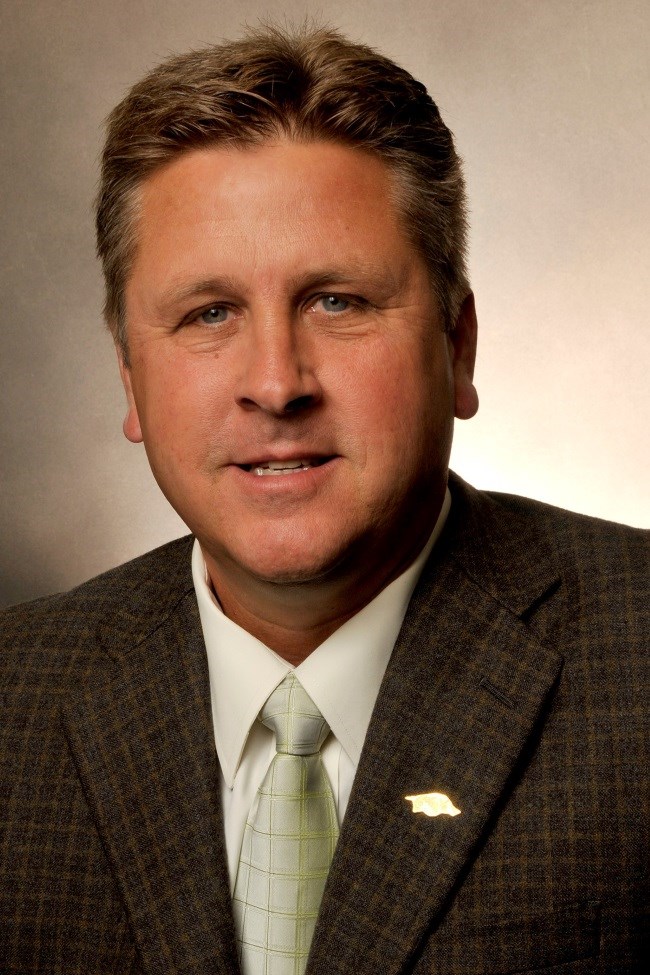Turfgrass Wetting Agent Studies Explore Application Rates and Timings

The Problem
Mike Richardson, professor of horticulture with the Arkansas Agricultural Experiment Station, says putting greens built to United States Golf Association specifications with 12-inch-deep sand root zones are especially prone to “localized dry spot” (LDS) — patches of dying or dead grass that are a byproduct of hydrophobic, or water repellent, soil. Hydrophobic areas in the root zone of these putting greens repel water instead of absorbing it to replenish the roots. Wetting agents, which are soil surfactants applied to turfgrass to address LDS, help mitigate water repellency by “building a bridge” between hydrophobic coatings on sand particles and water in the root zone.
The Work
Extensive wetting agent research has been conducted by experiment station researchers over the past two decades. Daniel O’Brien, a Ph.D. student working with Richardson, has continued the research on wetting agent functionality by testing different commercial products at different application rates and timings.
This research into wetting agent rates and timings has garnered support from golf course superintendent associations across three states, and a new version of the trial, set to begin in 2023, has received multi-year funding from the Golf Course Superintendents Association of America (GCSAA). The next phase of the trial will be in conjunction with Wendell Hutchens, assistant professor of turfgrass science, at the experiment station.
The current application rate study was conducted May through August 2021 and 2022. It examined six different wetting agents, each one applied six different ways, including an untreated control. The six products tested were: Cleanse, Distance (both Turf Fuel), Dispatch (Aquatrols Corp.), Magnus (Precision Labs), PBS150 (Aqua-Aid Solutions), and TriCure (Mitchell Products).
The different application strategies tested included: single application at the label rate; single application at twice the label rate; monthly applications at the label rate; monthly applications at half the label rate; and applications every two months at the label rate. Following each application, irrigation was applied to move all wetting agents into the root zone.

The Results
Preliminary results from the 2021-22 study emphasized how optimizing application rates and timings is product-specific, and there is not a one-size-fits-all strategy that works best across all wetting agents. While there was a general trend towards monthly applications (at both full and half rates) providing best turfgrass quality, depending on the product, less frequent and lower-rate applications demonstrated the ability to produce high quality putting green turf. These results have implications for cost savings as well as water savings, while still maintaining high overall turfgrass quality.
With the recent funding from GCSAA, this work will continue in 2023. Researchers will add in-ground soil moisture sensors to continuously monitor root zone water content, which will provide valuable insights into the duration of wetting agent effectiveness.
The Value
This work will ultimately help golf course superintendents manage their most critical resource — water — on the most intensively maintained, highest-value areas of their course — putting greens. By better understanding wetting agent efficacy and longevity, turfgrass managers can refine application rates and timings to maximize their benefits without overapplying.
A next step for future research, O’Brien said, is to develop reapplication models based on environmental conditions and move wetting agents from a calendar-based application schedule to one more reflective of temperature, moisture, and growing conditions. Golf course managers will be the primary beneficiaries of the research, but the work could also help homeowners, lawn care professionals and some sports field and court managers manage water resources.
O’Brien noted that, because of wetting agents’ importance on golf courses, turfgrass research has provided an excellent vehicle for studying these valuable products. However, the implications of wetting agent research are by no means limited to turfgrass. With the ever-increasing need for water conservation, wetting agents offer the potential for improved water management across numerous crops and agricultural situations.
About the Researcher

Mike Richardson
Professor of Horticulture
Ph.D., Agronomy, University of Georgia, Athens
MS, Agronomy, Louisiana State University /A&M, Baton Rouge
BS, Animal Sciences, Louisiana Tech University, Ruston
Dr. Mike Richardson has been a faculty member in the department of horticulture at the University of Arkansas since 1998. He teaches undergraduate and graduate courses in turfgrass management and conducts research on cultural practices that impact cool- and warm-season turfgrass production in transition zone environments.
Richardson has authored over 120 journal articles on turfgrass management and physiology, published 10 book chapters, and delivered over 300 invited lectures on various aspects of turfgrass management around the nation and world. Richardson has been recognized as a Fellow in both the Crop Science Society of America and the American Society of Agronomy and was awarded the Fred V. Grau Turfgrass Science Award. He has been recognized at the University of Arkansas with the Spitze Land Grant University Faculty Award of Excellence and with the Outstanding Faculty Mentor Award by the University of Arkansas Graduate School and International Education.

Daniel O’Brien
Ph.D. Student
Ph.D. and M.S., Horticulture, University of Arkansas
B.S., Agronomy and Soils, Auburn University
Daniel O’Brien is a horticulture Ph.D. student in the University of Arkansas Dale Bumpers College of Agricultural, Food and Life Sciences. He earned his bachelor’s degree in agronomy and soils from Auburn University and joined the U of A horticulture department in 2013 and completed his master’s degree in 2017. That year, he was recognized as a Future Leader in Science by the American Society of Agronomy, Crop Science Society of America, and Soil Science Society of America.
His research focuses largely on improving understanding of soil surfactants.

